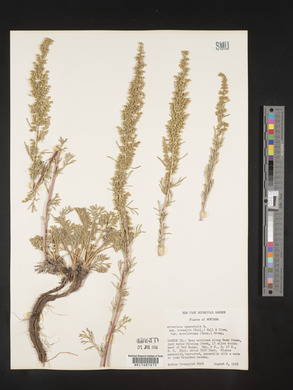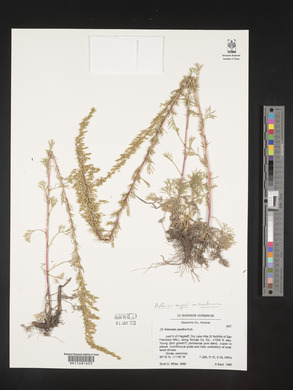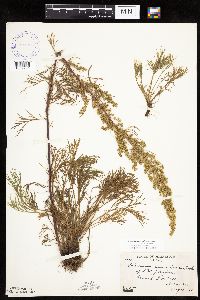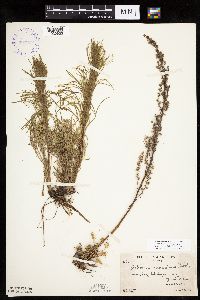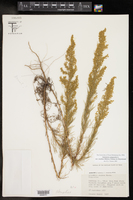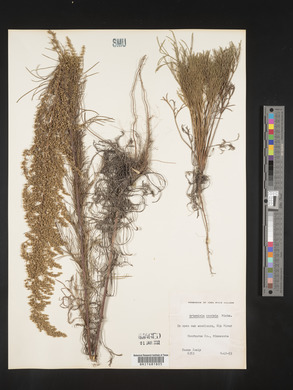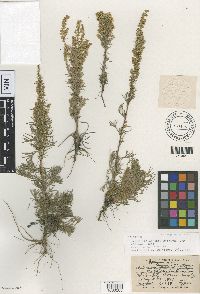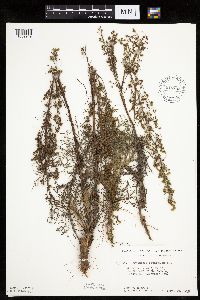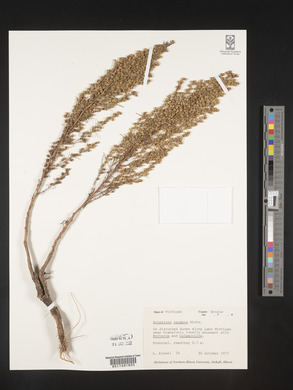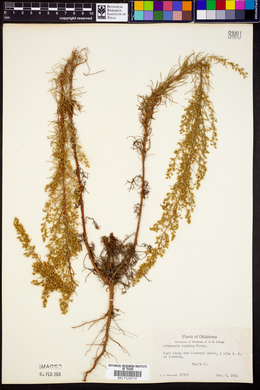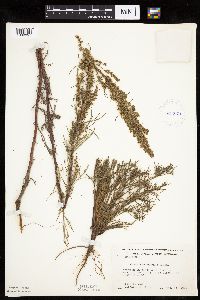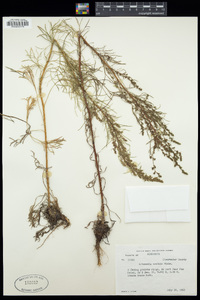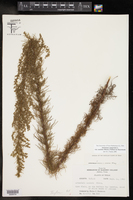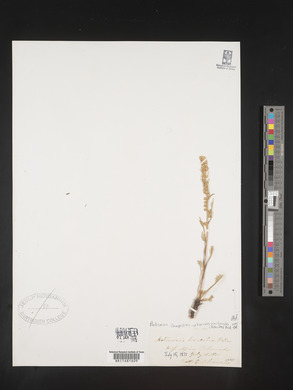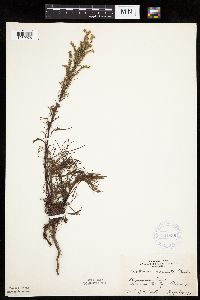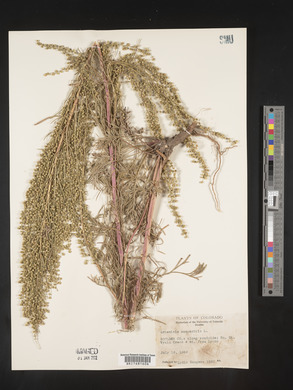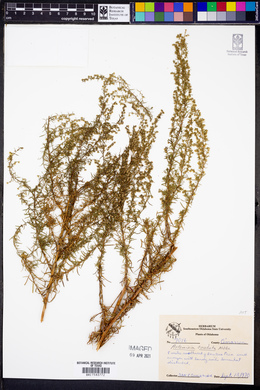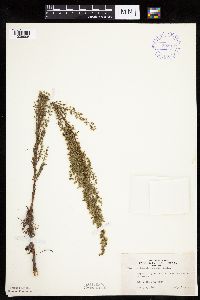Artemisia campestris
|
|
|
|
Family: Asteraceae
Pacific Wormwood
[Artemisia cordata] |
Biennials or perennials, (10-)30-80(-150) cm, faintly aromatic; taprooted, caudices branched. Stems usually 1-5, turning reddish brown, (often ribbed) tomentose or glabrous. Leaves persistent or deciduous, mostly basal; basal blades 4-12 cm, cauline gradually reduced, 2-4 × 0.5-1.5 cm, 2-3-pinnately lobed, lobes linear to narrowly oblong, apices acute, faces densely to sparsely white-pubescent. Heads (pedunculate) in (mostly leafless) paniculiform arrays. Involucres broadly turbinate, 2.5-3(-5) × 2-3.5(-7) mm. Phyllaries (margins scarious) glabrous or villous-tomentose. Florets: pistillate 5-20; functionally staminate 12-30; corollas pale yellow, sparsely hairy or glabrous. Cypselae oblong-lanceoloid, somewhat compressed, 0.8-1 mm, faintly nerved, glabrous. Artemisia campestris varies; each morphologic form grades into another. The present circumscription is conservative in that only three subspecies are recognized; the subspecies usually can be separated geographically as well as morphologically. Populations in western North America consist primarily of subsp. pacifica; east of the continental divide, plants are assigned to subsp. canadensis in northern latitudes and to subsp. caudata in southern latitudes.
FNA 2006, Jepson 1993, Kearney and Peebles 1969, Heil et al 2013 Duration: Perennial Nativity: Native Lifeform: Forb/Herb General: Aromatic biennial or perennial herbs, 30-100 cm tall, with a taproot and a branched caudex; stems reddish brown, ribbed, glabrous to tomentose. Leaves: Alternate and sessile; blades 2-3 times pinnately divided into narrow linear lobes, densely to sparsely white-pubescent; leaves reduced apically. Flowers: Flowering heads disciform, arranged in mostly leafless, spike-like panicles; involucre (the ring of bracts surrounding the flowering head) conic, 2-3 mm long, the bracts (phyllaries) glabrous to villous-tomentose, dry, membranous, overlapping; florets all discs, with pale yellow corollas; functionally staminate florets 12-30, surrounded by 5-20 pistillate florets. Fruits: Achenes oblong-lanceolate, glabrous, faintly nerved, 1 mm. Ecology: Found in meadows and sandy areas, from 4,000-8,500 ft (1219-2594 m); flowers July-October. Distribution: Widespread throughout N. America, to Alaska, Canada, and northern Eurasia. Notes: Distinguished by being a slender, aromatic perennial herb with 1-5 erect stems from a single base with a rosette of many leaves (leaves are not as condensed to the base in A. carruthii); green to bluish-gray-green leaves divided into thin lobes (lobes thicker in ludoviciana) with glabrous to sparsely hairy faces (tomentose in A. carruthii); and the top part of the plant, particularly the inflorescence, mostly leafless (leafy inflorescences in A. carruthii); inflorescence with many small heads dangling on short peduncles. This is a wide ranging species, with quite a bit of morphological variation throughout the range; populations in western North America belong to subsp. pacifica, distinguished by being perennials (the other subspecies are biennial) with persistent basal rosettes. Ethnobotany: Seeds were eaten as a grain; pulverized roots were used as a perfume; and the plant had extensive medicinal use, including treatment of coughs, colds, sores, rheumatism, eczema, tuberculosis, sore eyes, scalp infections, and sheep's sore backs; it was used to abort difficult pregnancies and ease difficult births; the fresh leaves were chewed for stomach troubles; the pulverized roots could be put on a sleeping man's face so his horses could be stolen. Etymology: Artemisia is named for Artemis, the Greek goddess of the hunt and namesake of Artemisia, queen of Anatolia; campestris means found in flats or plains. Synonyms: Artemisia campestris subsp. campestris, Artemisia campestris subsp. caudata, Artemisia caudata, Oligosporus campestris Editor: LCrumbacher 2011, FSCoburn 2014, AHazelton 2015 Scarcely odorous biennial or perennial 1-10 dm from a taproot; basal lvs crowded, 2-10 cm (petiole included) נ0.7-4 cm, twice or thrice pinnatifid or ternate, with mostly linear or linear-filiform segments seldom over 2 mm wide, glabrous to sericeous or villous, persistent or deciduous; cauline lvs similar but smaller and less divided, the uppermost often ternate or simple; infl small and spike- like to diffuse and panicle-like; invol glabrous to densely villous-tomentose, 2-4.5 mm; disk-fls sterile, with abortive ovary; achenes subcylindric; 2n=18, 36. Open places, often in sandy soil; circumboreal, extending s. to Fla. and Ariz. July-Sept. A complex sp., composed of many races, the taxonomy still confused. Ssp. caudata (Michx.) H. M. Hall & Clem., a robust, mostly single-stemmed biennial (occasionally short-lived perennial) to 1 m or more tall, occurring on dunes and other very sandy places along the coast and irregularly inland throughout our range, is well marked. Typically it is glabrous or subglabrous. A more hairy, scarcely definable phase of ssp. caudata, which occurs on the n. Great Plains and enters our range along the Great Lakes, has been called A. forwoodii S. Watson, but has no name under A. campestris. All or nearly all the rest of our material of A. campestris belongs to a phase that has been called A. canadensis Michx., or A. campestris var. canadensis (Michx.) S. L. Welsh. It is a ±multicipital perennial, seldom 6 dm, with fewer and often larger heads than ssp. caudata, occurring from Vt. and Minn. northward, often in the mts. In the broad sense the var. canadensis may be considered a part of A. campestris ssp. borealis (Pall.) H. M. Hall & Clem. Gleason, Henry A. & Cronquist, Arthur J. 1991. Manual of vascular plants of northeastern United States and adjacent Canada. lxxv + 910 pp. ©The New York Botanical Garden. All rights reserved. Used by permission. From Flora of Indiana (1940) by Charles C. Deam Indiana Coefficient of Conservatism: C = 5 Wetland Indicator Status: UPL |












